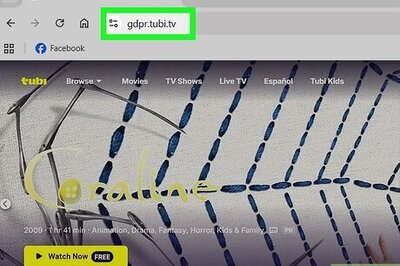
views
Establishing a Gua Sha Routine
Decide what you want to achieve through performing gua sha. Gua sha can be performed on the face or body for differing benefits, but a gua sha routine focuses on performing gua sha on your face to achieve physical, skincare-related, or mental wellness benefits. Have one or all of these goals in mind (or write them down!) to help you find a routine that aligns with your desired results. You should not perform or receive gua sha if you have diabetes, circulation issues, are on blood thinners, are or might be pregnant, have had Botox or other cosmetic fillers injected within the past four weeks, or have psoriasis, rosacea, or another skin issue. Unsure if you should perform gua sha on your face? Check with your doctor to decide what’s best. Facial gua sha is often practiced to achieve cosmetic and mental effects such as relaxing facial tension, stimulating lymphatic drainage to reduce puffiness, and providing calm through ritual. Researchers have examined gua sha’s effects on short-term pain relief when applied to the neck and back. Practitioners of traditional Chinese medicine, or TCM, also claim it can alleviate problems like migraines by promoting the body’s flow of qi (one’s life force, in TCM). However, research substantiating gua sha’s effects is limited and body gua sha is typically performed by professional practitioners of TCM. Talk with your doctor to see if gua sha is safe and appropriate for you.
Choose the right gua sha tool for your needs. Below is a breakdown of popular gua sha tools based on possible gua sha routine goals, as well as advice on tool shape and porosity. When it comes to price, keep in mind that some experts argue you can use any rounded tool to perform gua sha—even a wooden spoon—but you want something you can easily clean. For mental/spiritual wellness: You’ll likely want a gua sha (the term refers to the stone tool as well as the practice) associated with healing benefits according to traditional Chinese medicine (TCM). Jade is a popular material because of its cooling properties, and rose quartz is said to be ideal for those with sensitive skin. Look out for fake (glass or plastic) stones, and consider supporting Asian-owned brands when shopping for authentic gua sha that aligns with TCM principles. Avoid porous stones, as these can breed bacteria over time. For cosmetic benefits: Maneuverability and shape are important to consider when picking a gua sha tool. The popular heart-shaped gua sha is easy to hold, and its notch allows you to easily perform gua sha on the jawline and under eye area. A comb gua sha (also called a wave-shaped gua sha tool) offers ridges to perform gua sha on the scalp as well. Avoid porous tools that can breed bacteria, or weak tools (for example, plastic rollers) that could break easily.
Find the right facial oil or lotion for your routine. There’s no specific face oil or lotion used when performing gua sha. Pick an oil that suits your skin type, budget, and preferences regarding ingredients or fragrance. If you have sensitive skin, an oil-free face lotion may be a better choice than a face oil. You’ll apply the oil before beginning gua sha (and may need to reapply it throughout the process) to lubricate your skin and help the tool glide easily, so make sure you have enough! Look for a moisturizing face oil that’s suited to your skin type—if there’s already a skincare brand you love like Youth To The People or Drunk Elephant, see if they offer face oil.
Create a schedule based on your goals and availability. Gua sha is typically performed at least 2-3 times a week. However, some experts recommend using a gua sha tool once or twice a day as part of your regular skin care or self-care routines to create a consistent practice. Timing is also key—performing gua sha in the morning can address puffiness and energize your skin, while gua sha at night can help relax your facial muscles before bed. If you aren’t a morning person or only have time to perform gua sha on the weekends, plan a low-frequency routine. Try to space out the days you perform facial gua sha (for example, once every three days), especially if your goals are physical/cosmetic in nature. This way, you can attempt to consistently achieve results such as stimulating lymphatic drainage to reduce puffiness. When deciding when to perform gua sha at night, aim for fitting it in after cleansing your face and before putting on night creams or moisturizers. Since performing gua sha can increase blood circulation in the face, it’s believed by some experts to help with absorption of products. Set reminders on your phone, smart watch, or other device to help you remember when it’s time to perform gua sha. If you incorporate it into your morning or evening skincare routine, it should be easy to remember—but it never hurts to have a reminder. Performing a gua sha routine takes 3-5 minutes (or 7-10 if you adopt a longer routine), so you only have to allow a little time each day to reap the benefits!
Tweak your routine based on your results. Gua sha can increase blood circulation in the face to brighten skin by giving it a temporary glow. If you want to maintain this result, you may modify your routine to perform gua sha every morning. On the flip side, you may experience excess redness or bruising from gua sha. This could be a sign you’re performing gua sha too frequently, using the wrong oil or tool, or applying too much pressure. Try to diagnose the issue and tweak your routine accordingly.
Example Gua Sha Routine
Prep your skin by cleansing and applying facial oil or lotion. Clean skin will help prevent impurities from being absorbed into your skin while performing gua sha. Once you’ve cleansed, liberally apply facial oil to your skin to create a slippery surface for the gua sha tool.
Practice proper positioning, pressure, and gua sha technique. Position the tool at a 35-45 degree angle and only use light or medium pressure when gliding the tool over your skin. The tool should be flat against the skin, not perpendicular. Glide the tool in complete outward, upward strokes, three to five times per section of the face or neck, to help direct and stimulate lymph drainage. Start from the neck up to prevent fluids from getting trapped in the skin. An example of how your routine might progress is performing gua sha on the neck, throat, jawline, cheekbones, under the eyes, along the eyebrows, and over the forehead. You may simplify it if your goal is simply relaxation through the calming ritual of performing gua sha. While upward strokes are commonly advised in gua sha, you can also use downward strokes, particularly on the neck and shoulder area. Just go in one direction at a time, rather than scraping back and forth, to avoid aggravating the skin. Be mindful while performing gua sha and practice deep breathing to potentially reap mental wellness benefits such as stress relief and relaxation.
Watch videos to learn proper gua sha technique for each part of the face. For example, if using a heart-shaped gua sha tool, you typically use the long straight edge on the neck, but use the notch over the brow bone and under eye area. Seeing a routine performed can give you a sense of technique and timing, especially if you’re a beginner to gua sha. Some YouTube channels with popular Gua Sha tutorials to follow along with include Tina Engeo, All You Can Face, and Lémore Beauty. Be advised that videos may feature claims about gua sha’s effects that are not supported by research or empirical evidence. Currently, there is little or no research supporting the claims that gua sha can tone muscles, spot-reduce fat, or reduce wrinkles by promoting collagen production—so focus on achieving possible effects such as muscle relaxation, stress relief, skin brightening, and lymphatic drainage.
Gua Sha History
Gua Sha originated in traditional Chinese medicine (TCM). According to one TCM guru, it dates back to the Yuan Dynasty and was used to treat bodily collapses (like heatstroke) or seasonal diseases. It’s also used regularly today as an alternative medicine practice for treating chronic pain. Traditionally, it was performed with natural tools or stones. The name gua sha translates to ‘scrape’ (gua) and ‘petechiae’ (sha)—referring to the temporary, small red dots on the skin that appear when performing gua sha on the body to relieve pain and encourage healing.




















Comments
0 comment